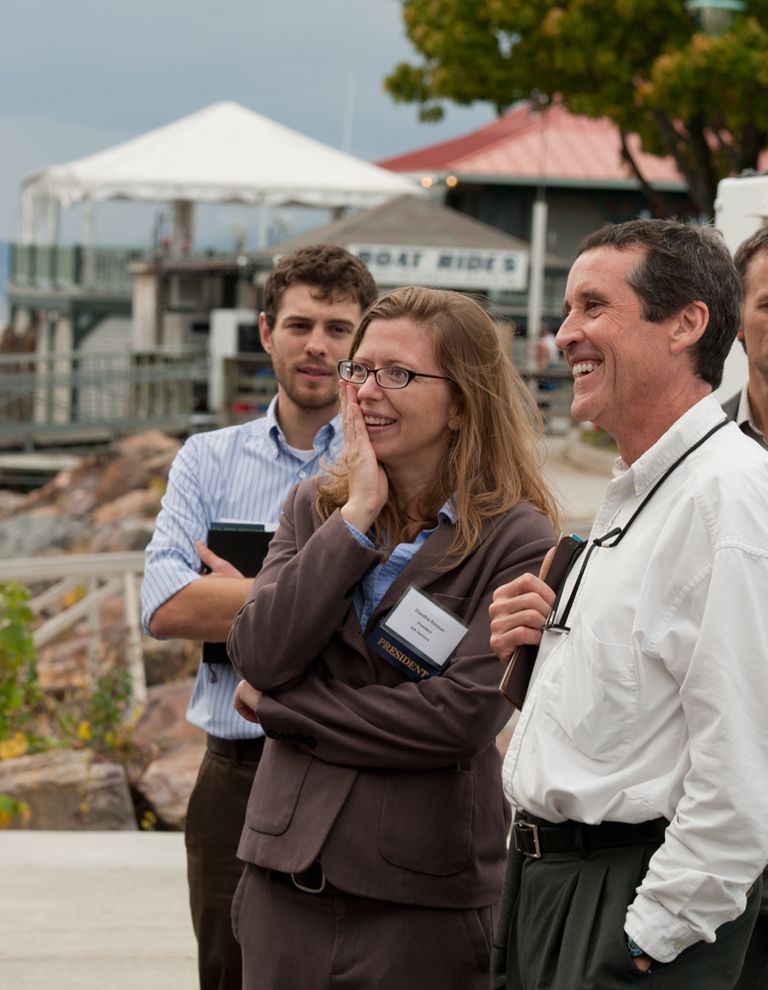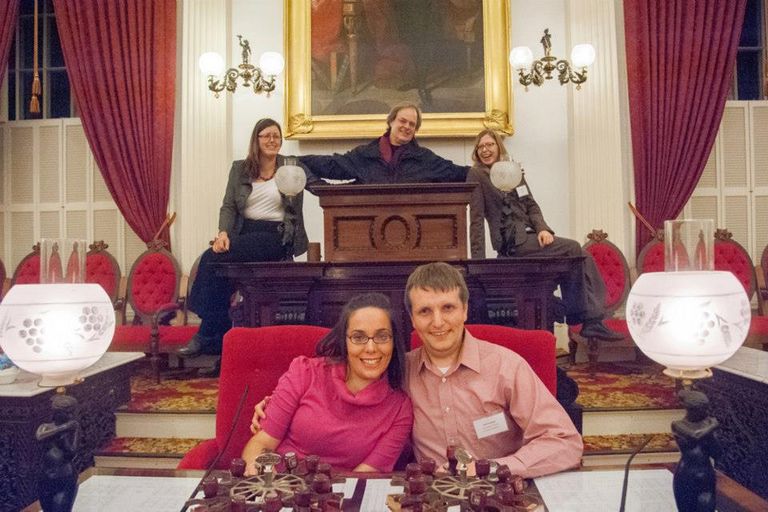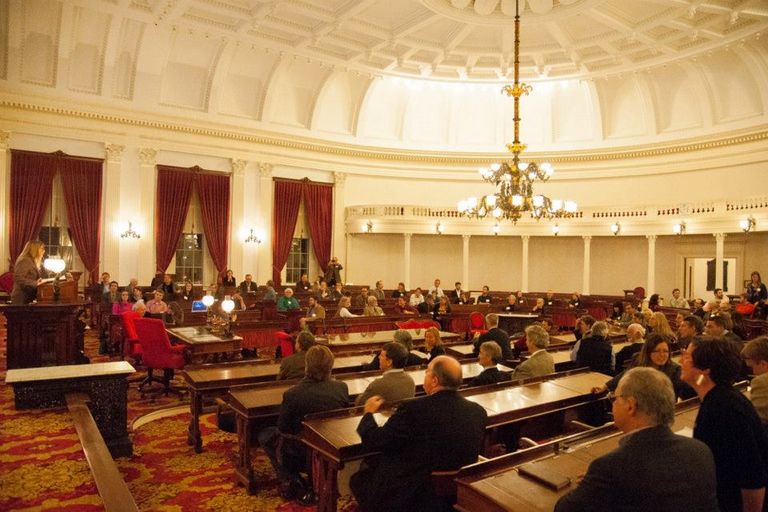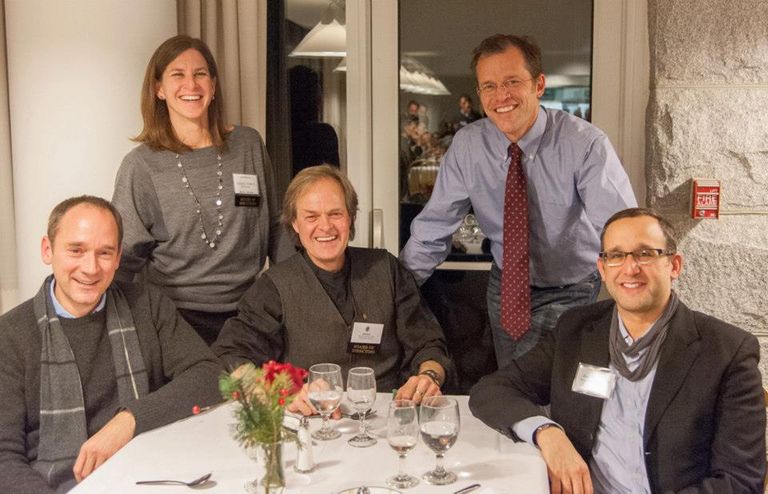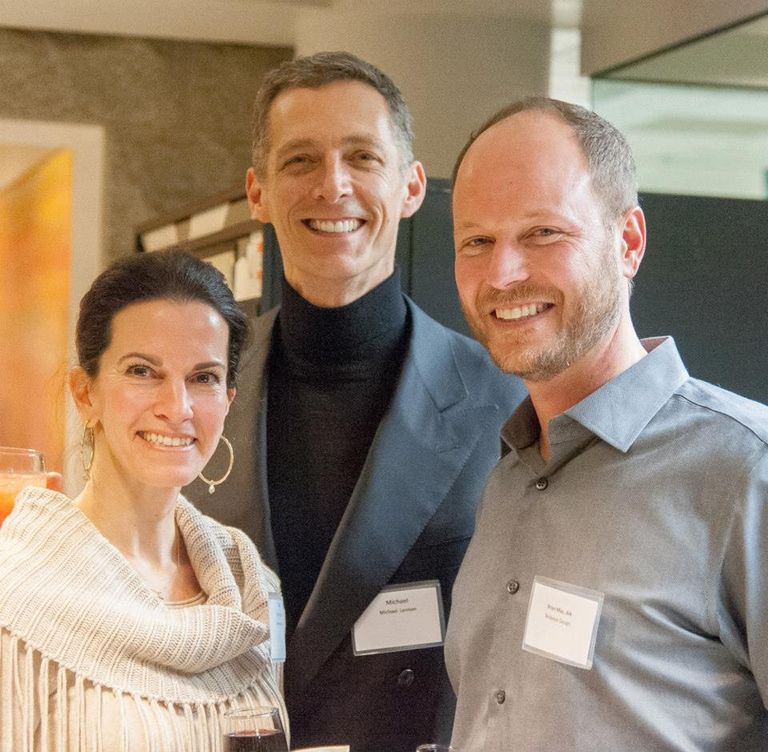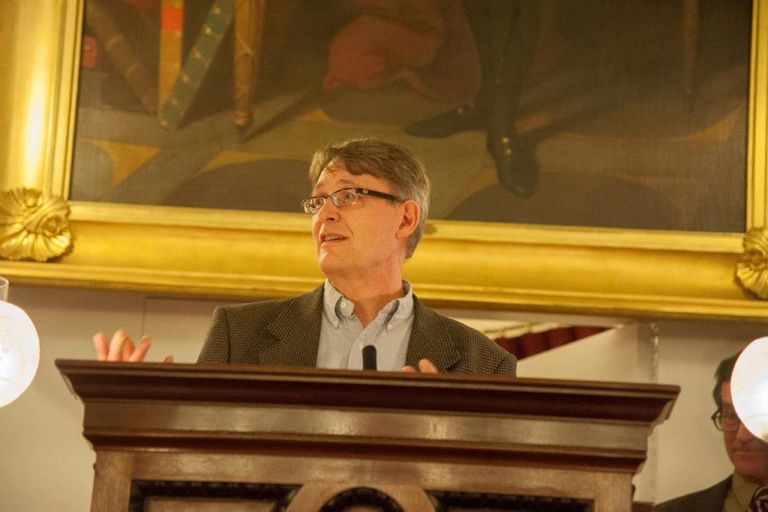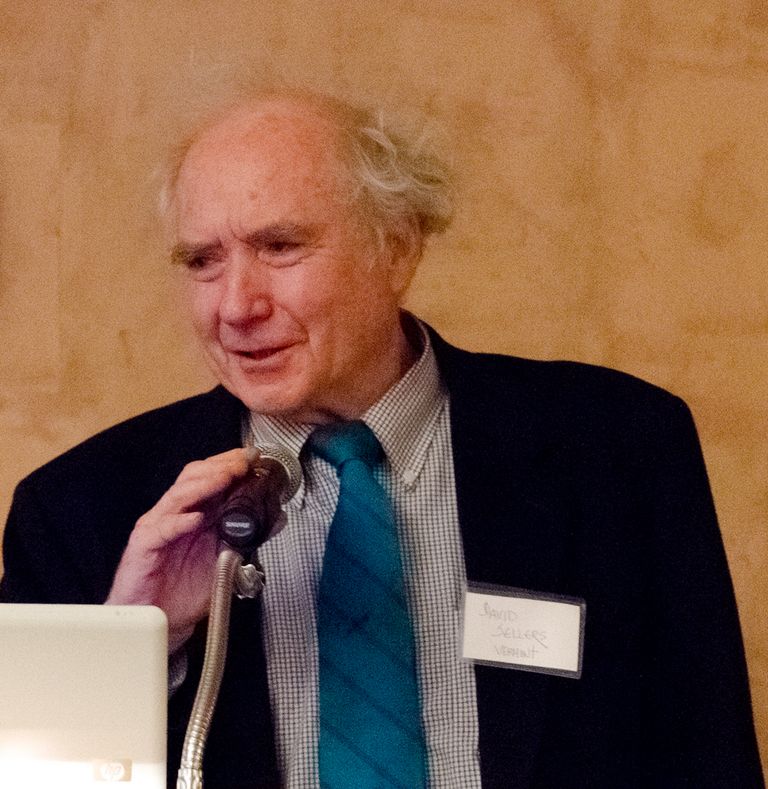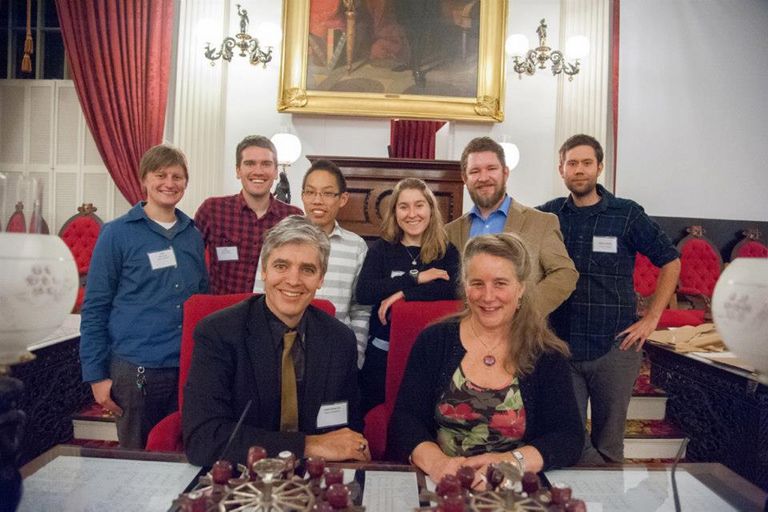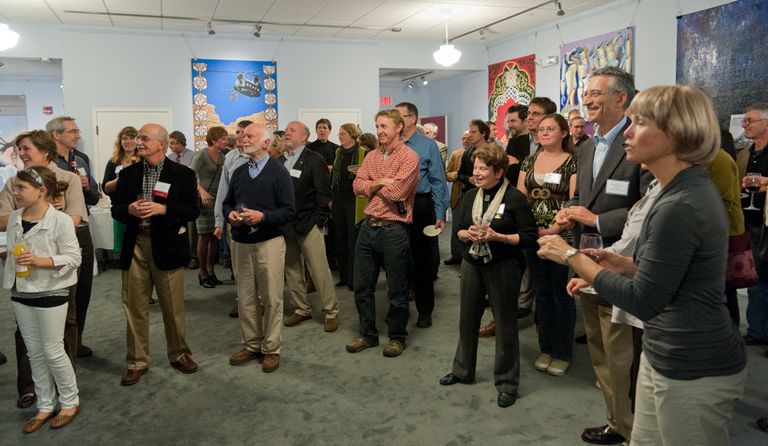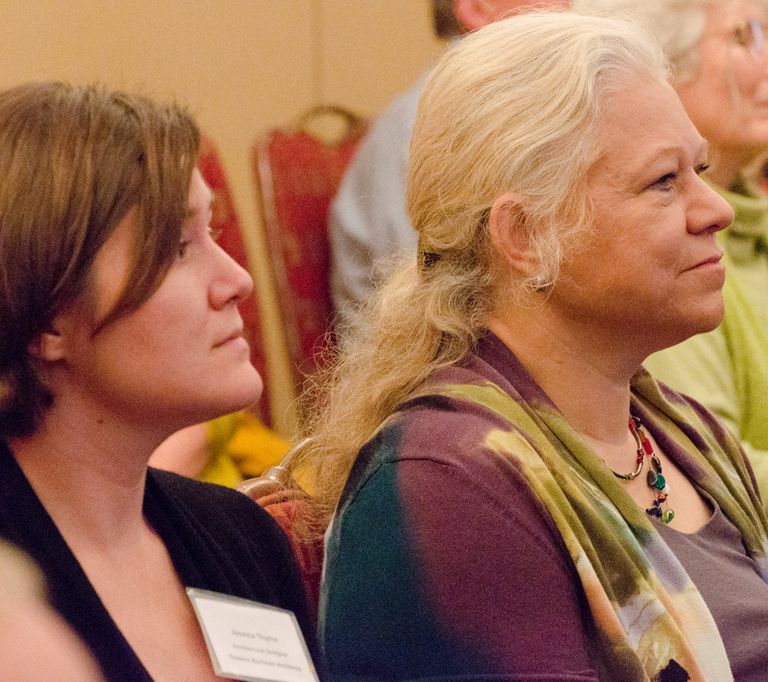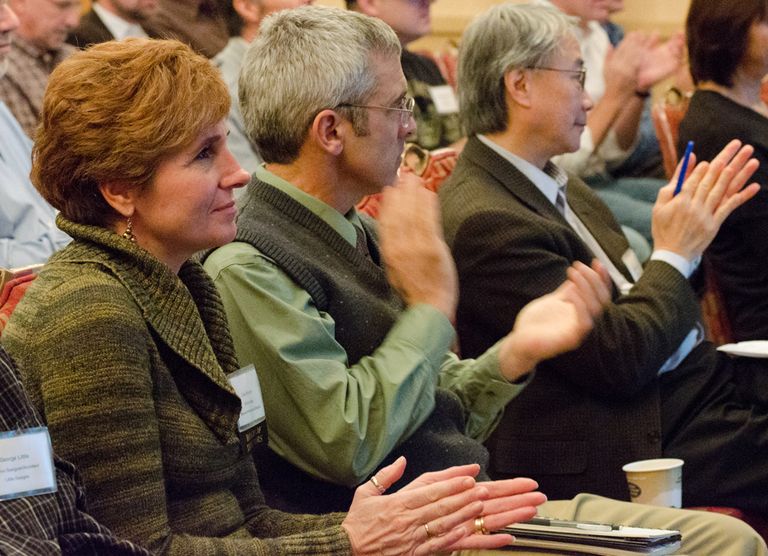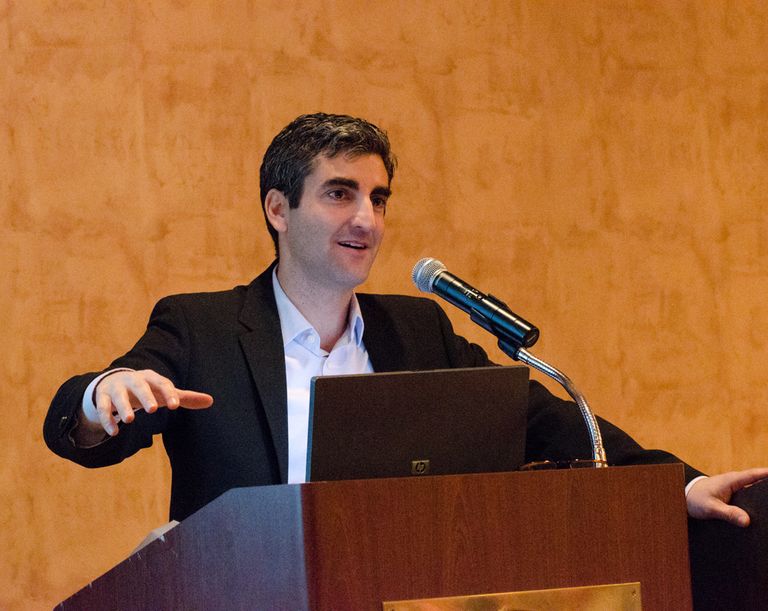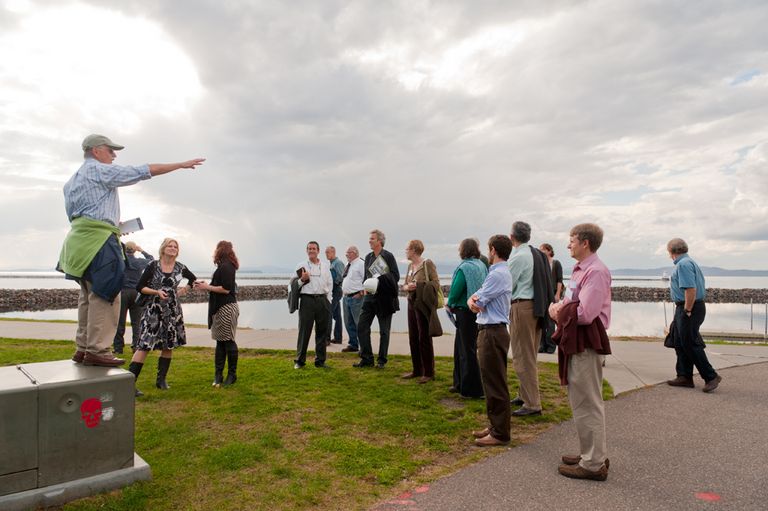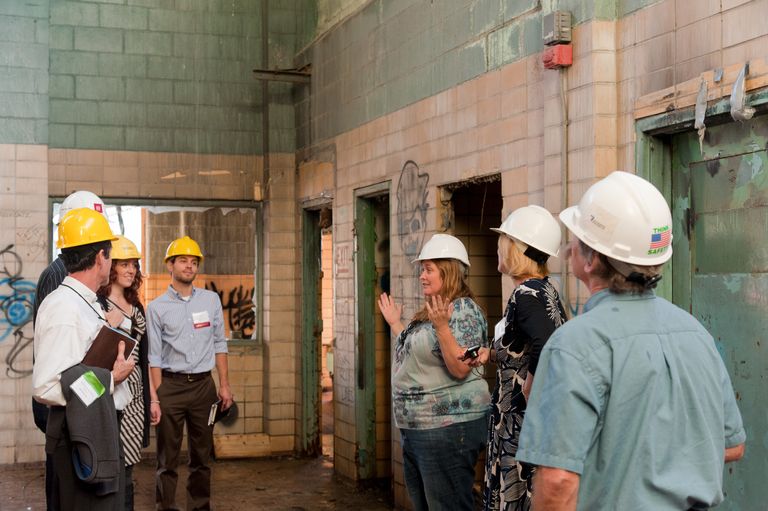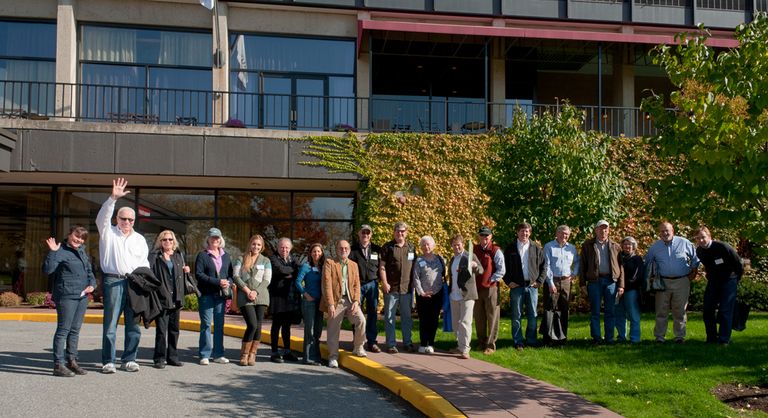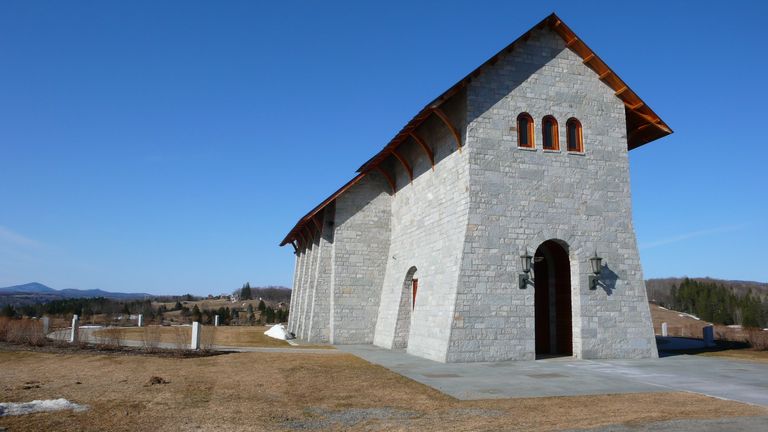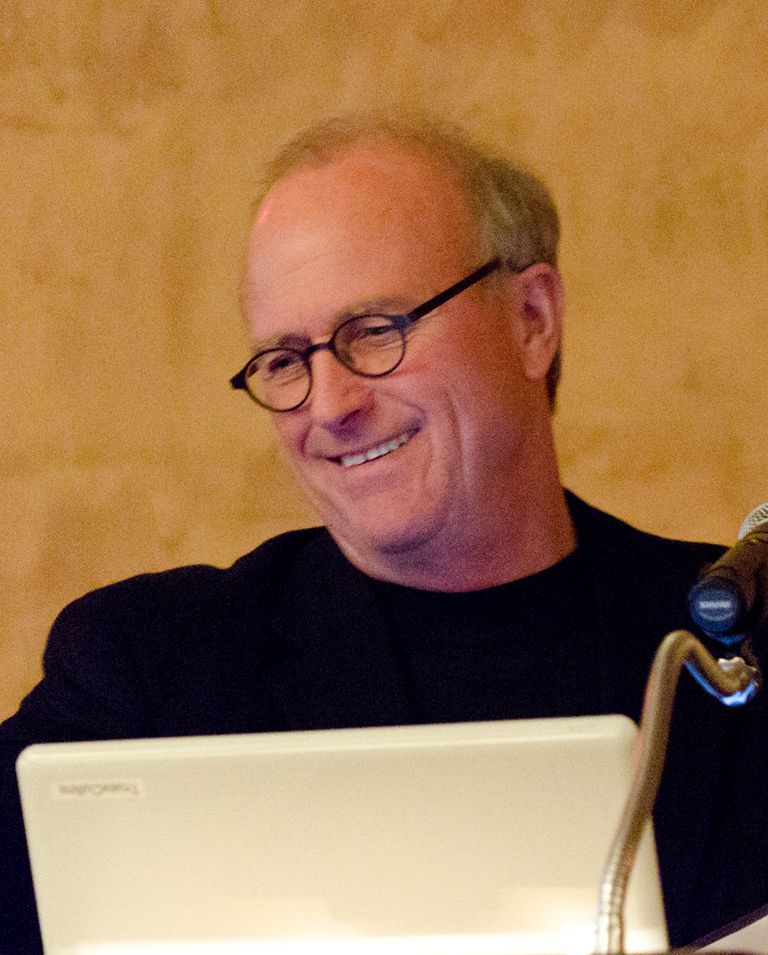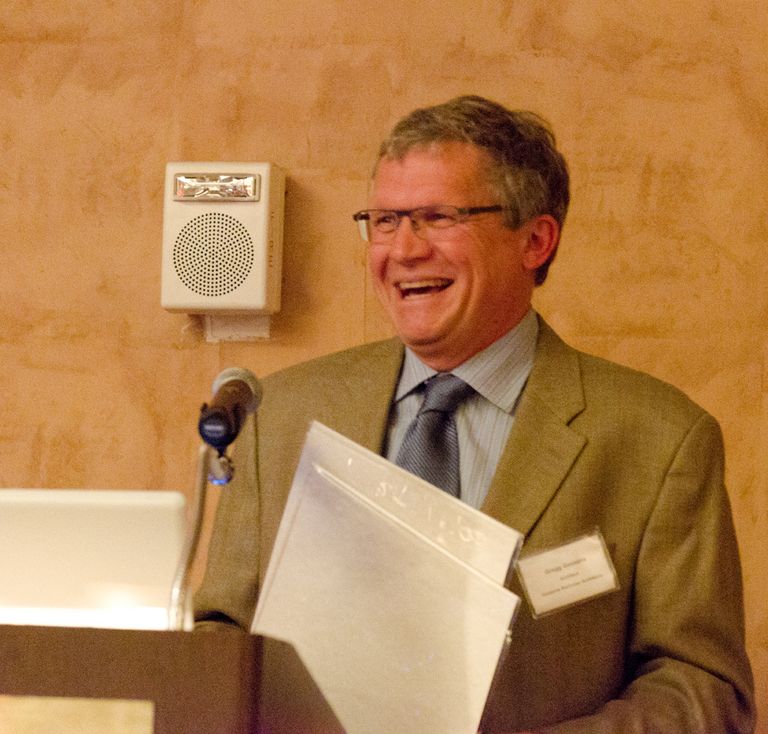12.12 AIAVT News
Design Awards Bash Breaks Attendance Records
AIAVT’s largest group ever—130 members and their colleagues—got together at this year’s Annual Meeting and Design Awards More...
AIA NEW ENGLAND
Since it would be nearly impossible to report on every aspect of the three-day event, this issue of AlAVT News recaps several highlights:
- AlANE: Overview & Thank You's
- Burlington Mayor Miro Weinberger's Talk
- "History of Burlington" Session
- People's Choice Awards Pavilion
- Vermont's AlANE Design Award Winners
AIAVT’s largest group ever—130 members and their colleagues—got together at this year’s Annual Meeting and Design Awards, held at the elegant Vermont Statehouse in Montpelier on December 6. Attendees began celebrating with drinks and appetizers in the dining area, moved to the awe-inspiring legislative chamber for the awards presentation, and headed back to the dining area for maple roast pork, seafood Newburg, and other tasty preparations. Here’s how to find out who took home the awards.
AIA NEW ENGLAND
AlANE: Overview & Thank You's
Attracting over 200 attendees from New England and New York, the 2012 AlA New England conference and design awards, hosted by AlAVT on October 19-21 at the Hilton Hotel, was a tremendous success. Upon returning home, attendee Sarah Armster, wife of award winner Wil Armster of AIACT, wrote to say, "This was the best AlANE awards ceremony we've been to-and we've been to several. Patricia Patkau was superb, kind, funny. And the staff did a great job."
Members and colleagues who were unable to attend are urged to enjoy the event vicariously through these AIA News stories and photographs. The following individuals are acknowledged for bringing their relentless energy and spectacular talents to bear in making AlANE a success:
AlANE Executive Committee: Barbara Conrey, AIA, Co-Chair; Diantha Korzun, AIA, Co-Chair; Cam Featherstonhaugh, Assoc. AIA; Lisa Rovner, AIA; Maura Wygmans, AIA
Awards Subcommittee: Tom Bachman, AlA; Josh Chafe, Assoc. AlA; Andrew Chardain, Assoc. AlA; Cam Featherstonhaugh, Assoc. AlA; Sarah Grenier, Tyler Gleeson Kobick; Jessica Thyme, Assoc. AlA
Communications Subcommittee: Carolyn Bates, Carolyn L. Bates Photography; Steve Clark, AlA; Candace Brownell, Windows & Doors by Brownell; Miana Hoyt Dawson, A.W. Hastings; Thomasina Magoon, Naylor & Breen Builders; Maura Wygmans, AlA; Carol Miklos, AIAVT
Organization & Logistics Subcommittee: Barbara Conrey, AlA; Mary Lintermann, Lisa Rovner, AIA
Programs Subcommittee: Diantha Korzun, AlA; Larry Dean, Assoc. AlA; Trish Densham, Engineering Ventures; Paul Duane, Efficiency Vermont; Diane Elliot Gayer, AlA; Dan Goltzman, AIA; Rolf Kielman, AlA; Bill Truex, FAIA
Adjunct Tour Guides: University of Vermont Tour: John Anderson, John Anderson Studio; Janet Ross, AlA; Richard Deane, AlA; Alex Halpern, AlA; Bill Maclay, AlA; Keith Robinson, Black River Design Architects; Michelle Smith, UVM • Champlain College Tour: Jean Carroon, FAIA; Tom Cullins, AlA; Adam Portz, SE Group; David Provost, Champlain College; Bob White, ORW Landscape Architects & Planners; Kevin Worden, Engineering Ventures • Burlington Historic Tour: Ron Redmond, Church Street Marketplace; Tom Simon, Esq., historian • Waterfront Tour: David Boehm, Engineering Ventures
Special Thanks: Jamie Carpenter, Assoc. AlA; Steve Clark (illustrator); Karl Fandrich, Assoc. AlA; Elena Rosen, AlAVT; Valerie Thibodeau, Dore & Whittier
Special Thanks to our Underwriter, Efficiency Vermont; our Sponsors: Marvin Windows and Doors, PC Construction, Engineering Ventures, The Sherwin-Williams Company, Curtis Lumber, Vermont Natural Coatings, Inc., DEW Construction Corp., The Garland Company, Naylor & Breen Builders, Inc., Loewen Window Center of VT & NH, and Engelberth Construction, Inc.; and our Exhibitors: Vermont Eco-Floors and Planet Hardwood
AIA NEW ENGLAND
Mayor Hopes to Chart New Course for Downtown Burlington
By Dick Nelson
Kicking off the AIA New England annual conference, Miro Weinberger, mayor of the host city, told visiting architects from around the six-state region that Burlington is on the cusp of a second renaissance, ready to build on past successes and spring forward into the new millennium.
Weinberger, a partner in The Hartland Group, a Burlington-based firm of community developers and consultants, said his administration is focused on making things happen, particularly in the area of the city between the overwhelmingly successful Church Street Marketplace and the still-evolving Lake Champlain Waterfront.
He started by enumerating the city's plusses, which he said the conference-attending architects would see for themselves as they took a variety of tours on the sun-splashed mid-October weekend.
“On your tours, you'll see historic houses on the hill. You'll see how urban renewal changed Burlington in a dramatic way. You'll see the Church Street Marketplace, one of only a handful of very successful pedestrian-only streets in the country. You'll see how our Waterfront Park reclaimed a great swath of the Lake Champlain waterfront and has become a great resource. The top of the hill, which includes our hospital and the University of Vermont, has seen major improvements as a result of great designs, great investments.”
But Weinberger also said much more remained to be done. “We're trying to bring in new investment,” he said. “Burlingtonians have an ambivalent view of development. Difficult memories persist (of bad development, during the era of urban renewal). Currently, we have a very complicated and uncertain regulatory environment. But now there's a new consensus that it's time to change the regulatory environment so that good, responsible real estate development can happen. My development background is an asset.”
Weinberger, 42, was valedictorian at Woodstock Union High School in 1988. He earned a Master of Urban Planning and Public Policy from Harvard University’s Kennedy School of Government. His architect father, Michael, was a longtime principal at Weinberger Associates in Woodstock. Miro Weinberger's company, Hartland Associates, has developed more than 200 units of sustainable housing in Vermont and New Hampshire, totaling over $40 million. Many have achieved LEED certification.
Although only in office six months, Weinberger seems to have a mandate that no other recent mayor has had. He became the first Democrat since before Bernie Sanders to win the mayoralty, with 58 per cent of the vote and a 21 per cent margin of victory. In October, the city council voted unanimously to move forward with new design for downtown redevelopment “that can inspire political consensus.”
The “Champlain Connector,” a hotly debated project for the past 50 years, has been redesigned from a “big superstructure, dumping into downtown” and the kind of design that “did great damage to other downtowns.” Now the city council has embraced a more modest street reconfiguration, “a new way of connecting Pine Street to Battery Street that everyone in the city can get behind, a project that enhances the city, that builds the city up, instead of tearing it down,” in the mayor's words.
Other opportunities exist to continue improvements on the waterfront, particularly in the area surrounding the long-abandoned “Moran Plant,” a former electricity generation station that has become an eyesore. Weinberger called this area “a jumbled mess,” featuring “potholed streets and a rundown skateboard park.” He envisions a “world class” skateboard park on the site, combined with a possible sailing center and other improvements.
“We want to bring new energy to downtown and to the waterfront,” Weinberger said.
“We want to get to the point where you can get a permit and get it quickly. We want to make Burlington a place that's accepting to solar installations. This will create the opportunity for innovative new architectural projects. I'm the son of an architect. I have great respect for this profession. You have the creativity and the innovative spirit that Burlington will need in the months and years ahead.”
AIA NEW ENGLAND
Whither Burlington? Panelists Look Back, And Forward
By Dick Nelson
The AIA New England annual conference, held at the Hilton Hotel in Burlington on October 19-21, afforded a variety of opportunities to learn about the city. On Saturday morning, visiting architects from the six-state area could choose to attend a presentation titled “Design of Burlington” that chronicled the city's evolution from its founding by the Allen Family in the mid-1700s, to its heyday as the lumber capital of New England, and up through its development today—with a look at what the future might hold as well.
Leading off, historian Tom Simon hearkened back to the city's beginnings, starting with the Allens. He then discussed the urban creation that took shape in the early 1800s, when the city's grid of streets that still exists today was mapped out and stores began to open shortly thereafter. The construction of a canal in New York State that created passage from the Hudson River to Lake Champlain provided another boost, as did the 1849 arrival of two railroads on the city's new waterfront, a part of which had been filled in to receive them. Industry began to boom.
“By 1850, almost all of Vermont's forests were gone,” said Simon, "so we started importing lumber from Canada. Lawrence Barnes, our most famous lumber tycoon, built the first planing mills. By 1870, Burlington was producing 115 million board feet of lumber per year, third in the country behind Albany and Chicago.”
The late 1800s were Burlington's heyday, Simon said, as compared with the early 1900s. Congress had passed an act to tax lumber imported from Canada in order to boost the timber industry in the Northwest U.S. As the mills faded, patent medicine factories opened, making drinks like Payne's Celery Compound. The medicine industry eventually tapered off as well.
By 1935, Burlington’s waterfront, once home to stacks of lumber, was now dotted with bulk petroleum tanks, explained Simon. “Things continued to stagnate until 1956,” he said, “when IBM came to Essex Junction.” The arrival of I-89 in 1962 spurred further changes, Simon said, playfully calling this the “Pre-Truex Era” as his co-presenter, Bill Truex, FAIA, Principal Emeritus, TruexCullins Architecture + Interior Design, took over the podium.
Old Urbanism
Truex had been on hand when Burlington had grappled with development, its residents rejecting the idea of an elevated highway into downtown and a rotary at the bottom of Main Street. Shelburne Road had begun to sprout strip malls, he explained, and urban renewal cleared seven city blocks in the late 1960s. Eight arson fires had also changed the face of the city’s downtown area. But it was something that was happening across the Atlantic that would dramatically alter Burlington as it is today, Truex said.
“In 1962, Copenhagen completed the world's first true pedestrian mall,” Truex noted. “It was magical and enticing compared to its traffic-clogged predecessor. It became the inspiration to transform Church Street into a pedestrian mall.” In 1970, the street was closed for a one-day fair, then in 1971 for a one-week craft fair. Other pedestrian malls were researched. Meanwhile, the Burlington Square Mall was opened, adding nearly 300,000 sq. ft. of climate controlled shopping to the city and connecting Church Street to the waterfront. The period from 1980 to 2012, said Truex, “has shown a tremendous maturation of the city, focusing on redevelopment of the Old North End. Pine Street has become home to many successful entrepreneurs.”
New activity was gradually starting to happen on the waterfront also. “By the 1990s, the boathouse was in place, but much of the remainder was still undeveloped,” said Truex. The ECHO Center, the boardwalk, and a community sailing center all followed, bringing things to where they are today. “There are also lots of future opportunities waiting for new entrepreneurs to come forward,” he added.
Sandrine Thibault, Burlington’s comprehensive planner, next stepped to the mike and noted, “My role is to cover today and the future.” She said Burlington has lots of untapped potential and that the new Mayor and his administration have been evaluating its current assets as well as those its citizenry would like to see.
Thibault discussed several aspects of the city that administrators view as top priorities for improvement. The first she mentioned was housing. “It's hard to find, and it's too expensive,” she said. “We need to build more housing of all kinds. Our vacancy rate is one per cent.”
Another priority Thibault cited was transportation. “If the pedestrian is king,” she said, “maybe the bike can be queen. We've also talked…about bringing the train back to downtown.”
Additional areas of improvement Thibault discussed were surface parking lots, the northern end of the marketplace, and Cherry Street. She said the Intervale, an area of strength for Burlington, with its focus on locally grown food, might be made more prominent in other areas. “Why not bring that to the marketplace? We could have little demonstration plots,” she said.
Thibault wrapped up her segment of the presentation with comments about the waterfront. She said the area “already has so much going on, but there's…more that could be going on,” through the addition of “more boat slips” and “a lot of stairway connections” for easier access.
AIA NEW ENGLAND
AIANE People's Choice Award Pavilion Draws Crowds, Press
By Carol Miklos
AIAVT’s Emerging Professionals Network led the charge to construct a visually arresting outdoor pavilion in Burlington, in an alley off Church Street, for the display of 90 architectural project posters in a People’s Choice Exhibit. The exhibit was part of the AIA New England Design Awards Program; its goal—to increase public awareness of and appreciation for architecture among the public—was more than met. Hundreds of passers-by engaged with the exhibit, and many more were exposed to it through significant media coverage in the Burlington Free Press and on two television stations.
“The pavilion—which came to life through the collaboration, sweat, and in-kind contributions of many AIAVT members and their colleagues—was up on Church Street for nearly a month this past fall,” said the team leader behind the installation, Cam Featherstonhaugh, Assoc. AIA, Maclay Architects, Waitsfield. “The exhibit featured a voting kiosk where over 300 visitors cast their vote for their favorite project.”
Exhibit entries were primarily the work of New England-based architects and ranged from commercial to residential. After the pavilion came down, a portion of the installation moved to the Burlington City Arts (BCA) Center for several weeks. BCA was a joint host of the exhibit. AIA National’s YAF Grant Program, Amoskeag Woodworking, R.K. Miles, BluePrints, etc., Classic Home Design & Construction, F. R. Lafayette, and St. Albans Glass provided funding, materials or logistical support for the project.
Among the many individuals who volunteered significant amounts of time to the design, construction, and promotion of the pavilion were: Josh Chafe, Assoc. AIA; Andrew Chardain, Assoc. AIA; Thorton Hayslett, Assoc. AIA; Tom Bachman, AIA; Tyler Gleeson Kobick; Jessica Thyme, Assoc. AIA; Stephanie Featherstonhaugh; Ben and Shawna O’Neill, Philip Wagner, AIA Emeritus; Maura Wygmans, AIA; Lisa Rovner, AIA; Dan Goltzman, AIA; Carolyn Bates, Russell Colvin, Art Rovner; Sarah Grenier; Carol Miklos; Barbara Conrey, AIA; and Diantha Korzun, AIA.
The recipients of the People’s Choice Awards were announced at the larger AIANE event on Saturday, October 20. Read more at “Member Firms 'Do Us Proud'” elsewhere in this issue.
AIA NEW ENGLAND
Member Firms “Do Us Proud” at 2012 AIANE Design Awards
By Carol Miklos
Three Vermont firms took home awards on October 20 at the 2012 AIA New England Design Awards, hosted this year by AIA Vermont at the Hilton Hotel as part of the AIANE annual conference. The Design Awards program featured 240 entries, with 90 of those entries also submitted for a separate People’s Choice Awards program.
The jury, composed of chair Patricia Patkau, MAIBC, principal, Patkau Architects and professor, University of British Columbia (UBC); Peter Cardew, principal, Cardew Architects and guest critic, UBC; and Matthew Soules, director, Matthew Soules Architecture and professor, UBC, said that the work of all the entrants, overall, was relatively simple in that it demonstrated restraint well suited to the current economic climate.
Robert Peabody Brown of St. Johnsbury received a Citation for a pavilion built on a modest budget in the Northeast Kingdom. The space is designed to host summer weddings, receptions and other public gatherings. The jury was especially impressed with the interior of the pavilion, which features 25-foot peaks inside that allow the space to feel ample even when full. “We all agreed that we would be quite happy to be married there,” Patkau said.
Another project built on a modest budget, Montpelier-based Gossens Bachman Architects’ own workspace, was recognized with a Citation. The jury said they “really liked the studio spaces and the recycled wood.”
The People’s Choice Award submissions were on exhibit for a month before the AIANE event in downtown Burlington, in an outdoor pavilion constructed by AIAVT. Over 300 visitors to the exhibit voted for their favorite projects. The Gesundheit Institute, a Hillsboro, West Virginia project built by Sellers & Co. Architects of Warren received the runner-up award, garnering just one less vote than the winner.
For information about all of the AIANE award winning projects visit www.aianewengland.org/designawards.html.
Calendar
1/15 Architectural Education Seminar—Windows and Doors-Hampton Inn, Colchester, HSW credits, call April at 802-861-6922
1/16/ Architectural Education Seminar—Windows and Doors-Hanover Inn, 2 South Main Street, Hanover, NH, HSW credits, call April at 802-861-4922
2/6-7 “Better Buildings by Design” Conference—presented by Efficiency Vermont, Burlington
1/23-5/3 Passive House Institute U.S. (PHIUS) Training Courses
Scholar Award Recipients Announced
By Carol Miklos
AIA Vermont granted five awards to students of architecture this year. The awards were made possible through the Hanne N. Williams Scholar Fund, which derives support from the AIAVT Guy Teschmacher Memorial Golf Tournament, the AIA National Component Matching Grant Program, and other sources.
In December, two students at Norwich University, the state’s only accredited school of architecture, were recognized for demonstrating serious interest in the practice of architecture, strong design skills, leadership potential, and an understanding of the profession’s responsibility to the community. Each student received $1,500.
Kaylan Aufdermaur, of Escalon, California, said she was “very excited and thankful” to have received the scholarship award for a third-year student. As part of her application, she presented a design for the Rutland Food Shelf; the basis for her design was to achieve serenity. “The interior incorporated a water wall to give the patrons a calm feeling when they come to get their food,” she said. “The roof also emulated water through the curved design.”
Montpelier resident Daniel Wheeler won the scholarship award for a rising second-year student at Norwich. Wheeler, the owner of a building company, once did carpentry work for Forever Young Treehouses.
Earlier in the year, two academic awards of $500 each were given to students in the Architectural and Building Engineering Technology Program at Vermont Technical College (VTC). The Ruth Freeman Award, given in memory of Vermont’s first female architect and president of AIAVT, was given to the student in the first architectural design studio class who showed the greatest promise: Kazimir Cunningham of Westfield, Vermont.
Cunningham said, “When I first walked into the drafting labs at VTC…and experienced for the first time the drawings on the walls in rooms full of drafting tables and the smell of erasers, I knew instantly that this is where I belonged.” Upon receiving the award, Cunningham said, “I am honored to receive this award…it is encouragement to keep working diligently towards the future.”
The second VTC award, given in memory of Robert Brady, a former AIAVT member and professor of architecture at VTC, was bestowed upon the sophomore who showed the greatest all-around academic achievement in the first three semesters of the standard curriculum: William A. Moore of Hinesburg, Vermont. Moore, a 25-year-old who enrolled in VTC after not being sure of what he wanted out of higher education the first time around said, “Winning this award validates my return to college, as acknowledgement of the hard work and dedication that I have put into my studies. Coming back to college was a life-changing move, and this award lets me know that it was the right decision.”
The fifth scholar award was given to Kortnee Hill, winner of Norwich’s “Best in Show” competition, held this past spring. Hill's project, one of 17 in the competition, was an office building and gallery designed to provide a sensory experience for individuals that are blind.
According to one of the judges, Diane Gayer, AIA, Vermont Design Institute, “Hill’s project stood out for all of us, because it asked us to step out of our normal frame of reference. The sight studies not only informed the student’s perception of space, but also ours. We all felt that her design was a coherent response to the research question and that the collection of drawings and models all worked as a complete whole to reflect the particular premise being explored.”
Kawiaka Wins Washington Monument Grounds Competition
Earlier this year, AIAVT member Karolina Kawiaka learned that she was one of two winners of the People’s Choice for the National Ideas Competition for the Washington Monument Grounds. The multi-stage competition, sponsored by George Washington University, attracted both entrants and voters from around the world.
Kawiaka, lecturer of architecture at Dartmouth College and principal of Karolina Kawiaka Studio, won for her scheme, “The People’s Forum,” which creates a national gathering place at the base of the Washington Monument. Kawiaka explains that the original plan for Washington, D.C. “…defined two axes representing presidential leadership and democratic governance. Two hundred years later that vision is realized by a civic place that tells the story of the Washington Monument, creates a public forum for gatherings, and completes a vision of the Mall as America’s front lawn.” AIAVT member and landscape architect Robert White worked with Kawiaka in the final stages of the competition.
The idea for the competition came out of a realization that while the Washington Monument continues to be the defining feature of the Washington skyline, at ground level its vast open space remains unfinished. The conversation created by the competition has quickly gained momentum since its inception in 2010.
Kawiaka is currently working on extending her People’s Forum design by developing a comprehensive plan for the National Mall with the National Coalition to Save Our Mall. For more information about the grounds competition, visit www.wamocompetition.org.

latest ACHIEVEMENTS
Burlington-based Marcel Beaudin, AIA Emeritus, was the subject of a recent profile in Dwell, which began, “Vermont-born architect Marcel Beaudin never planned to design buildings. Trained as a draftsman for the monuments his family’s granite-quarrying business produced, Beaudin was working as a junior designer of tombstones and mausoleums in New York when a fellow sculptor introduced him to Le Corbusier, who was in New York designing the United Nations headquarters at the time. Thirty seconds in Le Corbusier’s studio convinced Beaudin to drop his pursuit of sculpture and enroll in the School of Architecture at Pratt Institute in 1949.” Read more at: www.dwell.com/articles/Marcel-Beaudin.html.
Diane Elliott Gayer, AIA, and her Burlington-based Vermont Design Institute team members, Michael Oman of Oman Analytics and landscape architect Kathleen Ryan, received a Public Space Award from the Vermont Chapter of the American Society of Landscape Architects for a project in Morrisville. Gayer, who also had been hired by international development group DAI to work with the national parks system in Rwanda on the Nyungwe National Forest, wrote a story about her experience, focused on “designing for change.” The story appeared in a recent issue of Vermont Woman.
Ingrid Nichols, AIA, Banwell Architects, Quechee, was a speaker at the Architecture Boston Expo (ABX) in November. Nichols’’ session, "Green Schools from the Ground Up," was based on her firm’s experience as the architects for the recently completed middle school in Lebanon, New Hampshire. The session focused on how, despite a tough economy, the school gained community support for going beyond code requirements to build a high-performance structure that dramatically reduces energy use while creating a healthy, sustainable environment for learning. Built as a Northeast Collaborative for High Performance Schools building, the 110,000 sq. ft. space includes biomass heating, solar hot water, reclaimed roof water to flush toilets, and many other high performance features.
John Rahill, AIA, Black River Design Architects, Montpelier, was an invited speaker at the recent Affordable Comfort, Inc. New England Home Performance Conference in Springfield, Massachusetts. Rahill’s presentation, “Aesthetic Opportunities of Exterior Insulation,” focused on how decoupling the structure of a wood-framed building from its thermal envelope can yield significant, cost-effective energy improvements. Rahill showed examples of the insulation system in both residential and commercial applications.
AFFIFIATE News
NEW MEMBERS
Trumbull-Nelson Construction Company, Inc., of Hanover, New Hampshire and Montpelier, Vermont, has been a part of the Northern New England community since 1917. As Construction Managers, Trumbull-Nelson has completed a variety of Commercial, Institutional, Industrial and Residential Projects throughout the Region. The Company embraces an integrated design and team process to reduce initial and long-term project costs and environmental impact. For more information, visit, www.T-N.com.
ANNOUNCEMENTS
Gary Hall Photography’s work was recently featured in Vermont Life—in a story titled "After Irene"—and in Boston Architecture, for coverage of an AIA New Hampshire Boston Harbor boat tour. View the work at www.vermontlife.com/ and www.garyhallphoto.com/BOSTON_HARBOR_BOAT_TOUR/index.html.
Loewen Window Center of Vermont & New Hampshire recently moved from its Railroad Row location in White River Junction to a space around the corner at 52 Bridge Street, in a historic building restored by AIA member Daniel Johnson. The Loewen showroom will continue to specialize in contemporary and traditional high-performance windows, doors and architectural hardware. Other product lines include Tradewood, European-brand Drewexim, Inline Fiberglass Windows, Cobblestone wooden shutters and screens; and sand-cast, bronze-clad Rocky Mountain Architectural Hardware. For more information, visit www.LoewenVTNH.com.
AIAVT News is published by AIA Vermont, a Chapter of the American Institute of Architects.
Opinions are the author’s and not necessarily the views of AIAVT or any other organization.
AIAVT reserves the right to edit articles for available space and determine appropriate content prior to inclusion. Submissions must be received by the 15th of the month prior to publication.
For advertising rate and specifications, see our Media Kit.
Please send articles, notices, letters, and graphic submissions to the editor:
Carol Miklos, Executive Director, AIA Vermont
88 Blackbird Lane
Charlotte, Vermont 05445
802-425-6162

